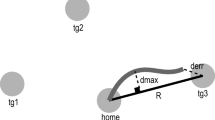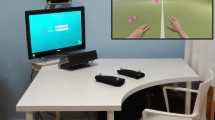Abstract
The capacity to plan movement following stroke is diminished when reaching from a standing position. Two mechanisms have been proposed: increased task complexity compared to simpler tasks and inhibition between the pathways controlling whole-body posture and upper extremity reaching. The objective of this study was to determine if task complexity alone can alter planning and release (or involuntary execution) capacity when whole-body postural adjustment is not required. Data were collected from 10 stroke survivors and 8 age-matched controls. Ballistic elbow extension movements were performed with and without voluntary shoulder abduction, adding complexity by anti-gravity arm support that enhanced the expression of abnormal muscle synergies linking elbow and shoulder after stroke. Our primary finding was in support of our hypothesis that startReact (involuntary release of planned movement by a startling stimulus) would be intact but that the increased task complexity would decrease the capacity to plan and release movement. StartReact was intact for both tasks with and without shoulder abduction. Despite the intact startReact response across both conditions following stroke, the incidence of startReact was decreased during the shoulder abduction task similar to prior studies showing a decrease during tasks of higher complexity. Our results suggest that individuals with stroke have a diminished capacity to plan and release movement as task complexity increases. This study highlights the unique potential for startReact to be used as a clinical tool to probe the capacity to plan and release movement following stroke and how that capacity is affected by the complexity of the task being performed. Such a tool may be useful for assessing functional impairments and tracking changes during the rehabilitation process.






Similar content being viewed by others
Data availability
The datasets generated during and/or analyzed during the current study are available from the corresponding author on reasonable request.
References
Bartels BM, Quezada MJ, Ravichandran VJ, Honeycutt CF (2021) Experts, but not novices, exhibit StartReact indicating experts use the reticulospinal system more than novices. J Mot Behav 53(1):128–134
Besomi M, Hodges PW, Clancy EA, Van Dieen J, Hug F, Lowery M, Merletti R, Sogaard K, Wrigley T, Besier T, Carson RG, Disselhorst-Klug C, Enoka RM, Falla D, Farina D, Gandevia S, Holobar A, Kiernan MC, McGill K, Perreault E, Rothwell JC, Tucker K (2020) Consensus for experimental design in electromyography (CEDE) project: amplitude normalization matrix. J Electromyogr Kinesiol 53:102438
Carlsen AN, Chua R, Inglis JT, Sanderson DJ, Franks IM (2004) Prepared movements are elicited early by startle. J Mot Behav 36(3):253–264
Carlsen AN, Dakin CJ, Chua R, Franks IM (2007) Startle produces early response latencies that are distinct from stimulus intensity effects. Exp Brain Res 176(2):199–205
Carlsen AN, Chua R, Dakin CJ, Sanderson DJ, Inglis JT, Franks IM (2008) Startle reveals an absence of advance motor programming in a Go/No-go task. Neurosci Lett 434(1):61–65
Carlsen AN, Maslovat D, Lam MY, Chua R, Franks IM (2011) Considerations for the use of a startling acoustic stimulus in studies of motor preparation in humans. Neurosci Biobehav Rev 35(3):366–376
Choudhury S, Shobhana A, Singh R, Sen D, Anand SS, Shubham S, Baker MR, Kumar H, Baker SN (2019) The relationship between enhanced reticulospinal outflow and upper limb function in chronic stroke patients. Neurorehabil Neural Repair 33(5):375–383
Coppens MJM, Roelofs JMB, Donkers NAJ, Nonnekes J, Geurts ACH, Weerdesteyn V (2018) A startling acoustic stimulus facilitates voluntary lower extremity movements and automatic postural responses in people with chronic stroke. J Neurol 265(7):1625–1635
Dewald JPA, Pope PS, Given JD, Buchanan TS, Rymer WZ (1995) Abnormal muscle coactivation patterns during isometric torque generation at the elbow and shoulder in hemiparetic subjects. Brain 118:495–510
Ellis MD, Schut I, Dewald JPA (2017) Flexion synergy overshadows flexor spasticity during reaching in chronic moderate to severe hemiparetic stroke. Clin Neurophysiol 128(7):1308–1314
Harrell FE (2001) Regression modeling strategies. Springer, New York
Hauck WW, Donner A (1977) Wald’s test as applied to hypotheses in logit analysis. J Am Stat Assoc 72:851–863
Hedeker D, Gibbons RD (2006) Longitudinal data analysis. Wiley, New York
Honeycutt CF, Perreault EJ (2012) Planning of ballistic movement following stroke: insights from the startle reflex. PLoS ONE 7(8):e43097
Honeycutt CF, Perreault EJ (2014) Deficits in startle-evoked arm movements increase with impairment following stroke. Clin Neurophysiol 125(8):1682–1688
Honeycutt CF, Kharouta M, Perreault EJ (2013) Evidence for reticulospinal contributions to coordinated finger movements in humans. J Neurophysiol 110(7):1476–1483
Honeycutt CF, Tresch UA, Perreault EJ (2015) Startling acoustic stimuli can evoke fast hand extension movements in stroke survivors. Clin Neurophysiol 126(1):160–164
Jankelowitz SK, Colebatch JG (2004) The acoustic startle reflex in ischemic stroke. Neurology 62(1):114–116
Kirkpatrick NJ, Ravichandran VJ, Perreault EJ, Schaefer SY, Honeycutt CF (2018) Evidence for startle as a measurable behavioral indicator of motor learning. PLoS ONE 13(5):e0195689
Marinovic W, Brauer SG, Hayward KS, Carroll TJ, Riek S (2016) Electric and acoustic stimulation during movement preparation can facilitate movement execution in healthy participants and stroke survivors. Neurosci Lett 618:134–138
Maslovat D, Hodges NJ, Chua R, Franks IM (2011) Motor preparation of spatially and temporally defined movements: evidence from startle. J Neurophysiol 106(2):885–894
Maslovat D, Drummond NM, Carter MJ, Carlsen AN (2015) Reduced motor preparation during dual-task performance: evidence from startle. Exp Brain Res 233(9):2673–2683
McCombe Waller S, Yang CL, Magder L, Yungher D, Gray V, Rogers MW (2016) Impaired motor preparation and execution during standing reach in people with chronic stroke. Neurosci Lett 630:38–44
McPherson JG, Chen A, Ellis MD, Yao J, Heckman CJ, Dewald JPA (2018) Progressive recruitment of contralesional cortico-reticulospinal pathways drives motor impairment post stroke. J Physiol 596(7):1211–1225
Montgomery D (2013) Design and analysis of experiments. Wiley, New York
Rahimi M, Honeycutt CF (2020) StartReact increases the probability of muscle activity and distance in severe/moderate stroke survivors during two-dimensional reaching task. Exp Brain Res 238(5):1219–1227
Rahimi M, Swann Z, Honeycutt CF (2021) Does exposure to startle impact voluntary reaching movements in individuals with severe-to-moderate stroke? Exp Brain Res 239(3):745–753
Schwerin S, Dewald JP, Haztl M, Jovanovich S, Nickeas M, MacKinnon C (2008) Ipsilateral versus contralateral cortical motor projections to a shoulder adductor in chronic hemiparetic stroke: implications for the expression of arm synergies. Exp Brain Res 185(3):509–519
Sokal RR, Rohlf FJ (2012) Biometry : the principles and practice of statistics in biological research. W. H. Freeman, New York
Yang CL, Creath RA, Magder L, Rogers MW, McCombe Waller S (2019) Impaired posture, movement preparation, and execution during both paretic and nonparetic reaching following stroke. J Neurophysiol 121(4):1465–1477
Acknowledgements
The authors wish to acknowledge Tim Haswell for technical assistance. This work was supported by NIH R01 NS053813 and R00 HD073240.
Author information
Authors and Affiliations
Corresponding author
Ethics declarations
Conflict of interest
The authors have declared that no competing interests exist.
Additional information
Communicated by Winston D. Byblow.
Publisher's Note
Springer Nature remains neutral with regard to jurisdictional claims in published maps and institutional affiliations.
Rights and permissions
About this article
Cite this article
Lee, H., Honeycutt, C. & Perreault, E. Influence of task complexity on movement planning and release after stroke: insights from startReact. Exp Brain Res 240, 1765–1774 (2022). https://doi.org/10.1007/s00221-022-06368-w
Received:
Accepted:
Published:
Issue Date:
DOI: https://doi.org/10.1007/s00221-022-06368-w




